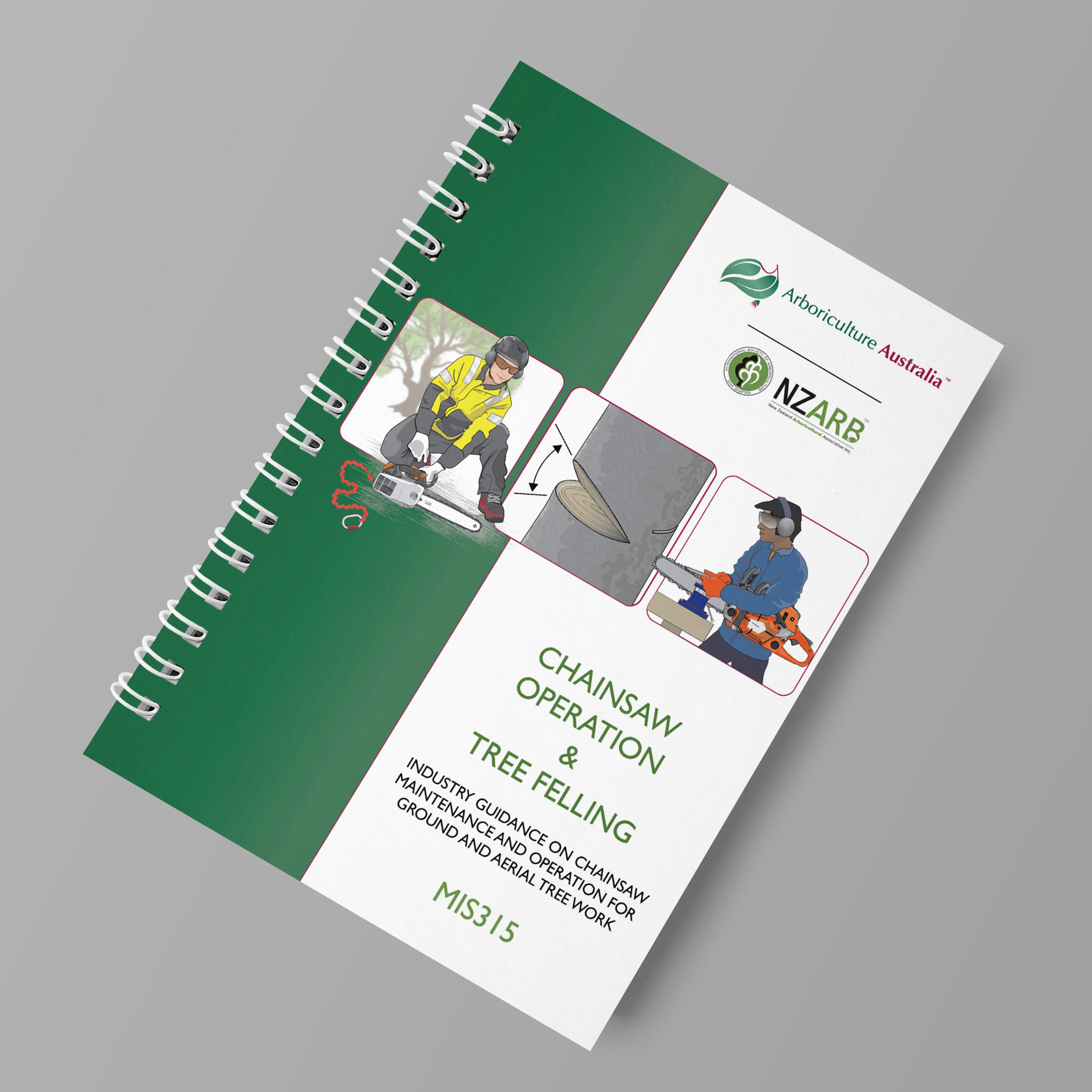A Minimum Industry Standard for Chainsaw Use and Tree Felling
This standard covers the work tasks of preparing, maintaining and using chainsaws, as well as tree felling using a variety of cuts and techniques both from the ground and whilst working at height.
About the MIS Series
This book is one in a series of Minimum Industry Standards (MIS) produced by Arboriculture Australia Ltd and the New Zealand Arboricultural Association in consultation with the national arboriculture community in both countries. These industry peer-reviewed documents provide a ‘body of knowledge’ which is shared by practitioners and can be used as the basis for training, dissemination of skills and professional development.
MIS315 – Chainsaw Operation and Tree Felling (Non-Member Price)
1: Introduction to chainsaws
Chainsaw components and terminology
Powerhead
Cutting attachment
- Drive sprocket
- Guide bar
- Saw chain
Battery saws
Top-handled saws
2: Chainsaw maintenance
Pre-start checks and routine maintenance
- Mixing fuel
- Common fuel:oil mixtures
Periodic maintenance
Sharpening saw chain
- File size and depth gauge chart
- Work position for sharpening
- Sharpening sequence
3: Chainsaw operation
Chainsaw safety: general principles
General principles of safe work and risk management
Personal Protective Equipment for chainsaw use
Working with chainsaws
Starting the chainsaw
- Drop starting
- Starting a top-handled saw
- Starting a saw in a MEWP
Using a chainsaw
- Basic operation principles
- Operating the chain brake
- Work positions for chainsaw operation
- Chainsaw reaction forces
- Kickback
- Good saw control
- Bad saw control
- Shortcuts and bad habits
- Boring cuts
Trimming and crosscutting
Internal stress in branches and timber
General safety principles for trimming and crosscutting
- Trimming patterns
- Crosscutting
Cut sequences for crosscutting
Processing uprooted trees
4: Tree felling
General principles of directional felling
Standard directional felling cuts
- How directional felling cuts work
The function of hingewood
- Compromised hingewood
- Trees with side lean
Scarf types and features
- Anatomy of a standard scarf
- Humboldt scarf
- Open-face scarf
- 90° scarf
Back cut
- Anatomy of a back cut
Incorrect cuts and felling risks
- Scarf cut too deep
- Scarf cuts not matching (undercutting)
- Scarf cuts not matching (scarf line incorrect)
- Back cut too low
- Back cut overcut (cut through hinge)
- Barber’s chair
Standard tree felling procedure
1. Identify potential fall zone(s)
- Estimating furthest point of impact
- Additional considerations for furthest point of impact
- Estimating area of fall zone
- Margin of error
- Preparing the fall zone for tree felling
2. Determine if it is possible to fell the tree into the fall zone
- Natural lean of tree
- Hinge control
- Tree-specific hazards
- Crew ability
- Reasonable worst case
3. Confirm plan with crew and assign work roles
4. Prepare for felling
- Clean around base of tree
- Prepare escape routes
- Set pulling ropes or guy ropes
- Prepare other equipment
5. Perform felling operation
5.1. Cut the scarf
- Work position for scarf cutting
- Hand position for scarf cutting
- Using the gunning sights
- Scarf cuts on larger diameter trees
- Wing cuts
5.2. Make the back cut
- Planning the back cut
- Back cut method 1: straight cut
- Back cut method 2: bore cut
- Back cut method 3: safe corner method
5.3. Use wedges or pulling ropes
5.4. Use escape routes
5.5. Check for hazards before returning to stump
Additional felling techniques
Wedges
- How wedges work
- Wedge selection
- Using wedges
Small trees
- Wedge bore method
- Quarter cut / split-level cut
Large trees
- Centre scarf method
Standing timber
- Cut techniques for standing timber
Forward-leaning trees
- Back-release cut (strap cut)
Backward-leaning trees
Trees with a sideways lean
- Tapered hinge and wedge
Trees with compromised timber
- Compromised hingewood
- Cavities and burnt-out trees
Trees with multiple leaders
Pulling ropes
General principles for use of pull ropes in felling
- Leverage
- Angle of pull
- Direction of pull
- Pulling against a side lean
- Method of pull
Key safety points for pulling trees
Felling sequence when using pulling ropes
- 1: Install the pulling rope (throwing knot)
- Moving the pulling rope into a union
- Using a throwline
- Manipulating a throwline
- Setting the rope with the throwline
- Tying off the rope
- 2: Pre-tensioning the rope
- 3: Cut the scarf and back cut
- 4: Drive wedges in the back cut
- 5: The feller should leave the base of the tree
- 6: The tree is pulled over
Pulling heavily-leaning trees
- Limiting factors for tree pulling
Guying trees for felling
- Planning to guy a tree during felling
- Key points for felling guyed trees
- Side-stepped cuts
Machine-assisted felling
- Stepped-down back cuts
5: Chainsaw use at height
- Tree access methods
- General principles for chainsaw use at height
Work positioning
- Bad working positions
- Good working positions
- Attachment points when climbing and cutting
Off-handed and one-handed saw use
- Off-handed use of rear-handled saws
- One-handed use of top-handled saws
Cut sequences and techniques – branches
- Straight back cut
- Step cut – undercut made first – top cut inside
- Step cut – undercut made first – top cut outside
- Step cut – top cut made first
- Step cut – vertical cuts
- Scarf and back cut – downward
- Scarf and back cut – upward
- Box cut
- Scarf and back cut – directional hinge
Cut sequences and techniques – tree heads and timber
- Felling the head out of a tree
- Felling sections of timber
- Felling sections of timber – landing sections flat
- Cutting techniques where trunk diameter is greater than bar length
- Blocking down: step cuts on timber
Felling techniques for tree dismantling – use of wedges and pulling ropes
